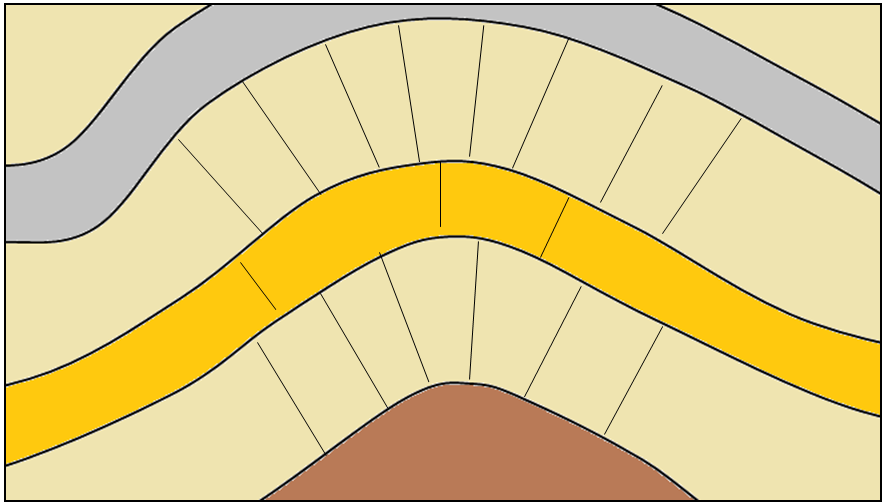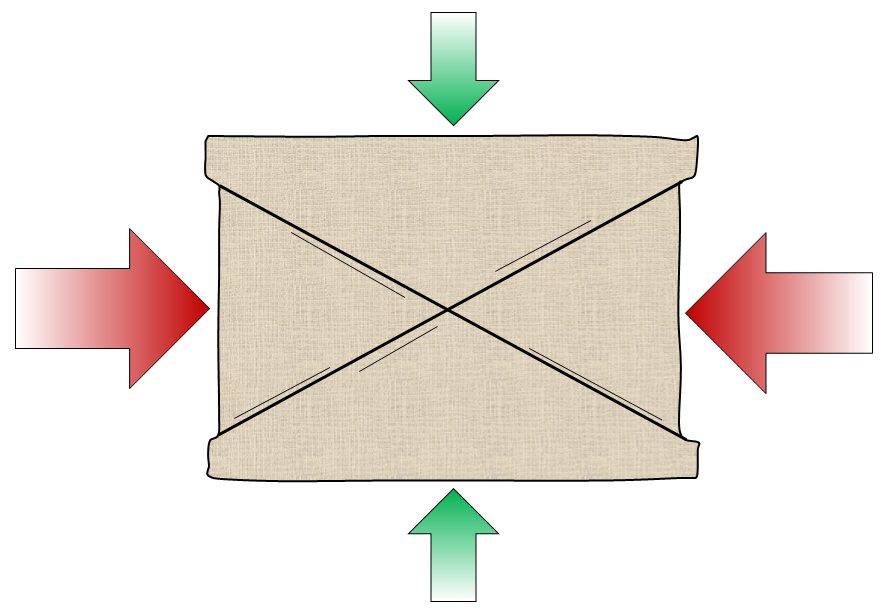9.3 Fracturing and Faulting
A body of rock that is brittle—either because it is cold or because of its composition, or both— is likely to break rather than fold when subjected to stress, and the result is fracturing or faulting.
Fracturing
Fracturing is common in rocks near the surface, either in volcanic rocks that have shrunk on cooling, or in other rocks that have been exposed by erosion and have expanded.

A fracture in a rock is also called a joint. There is no side-to-side movement of the rock on either side of a joint. Most joints form where a body of rock is expanding because of reduced pressure or where the rock itself is contracting but the body of rock remains the same size. In all of these cases, the pressure regime is one of tension as opposed to compression. Joints can also develop where rock is being folded because, while folding typically happens during compression, there may be some parts of the fold that are in tension (Figure 9.3.1).

Finally joints can also develop when rock is under compression as shown on Figure 9.3.2, where there is differential stress on the rock, and joint sets develop at angles to the compression directions.
Faulting
A fault is a boundary between two bodies of rock along which there has been relative motion. As we discussed in Chapter 11, an earthquake involves the sliding of one body of rock past another. Earthquakes don’t necessarily happen on existing faults, but once an earthquake takes place a fault will exist in the rock at that location. Some large faults, like the San Andreas Fault in California, show evidence of hundreds of kilometers of motion, while others show less than a millimeter. In order to estimate the amount of motion on a fault, we need to find some geological feature that shows up on both sides and has been offset (Figure 9.3.3).

There are several kinds of faults, as illustrated on Figure 9.3.4, and they develop under different stress conditions. The terms hanging wall and footwall in the diagrams apply to situations where the fault is not vertical. The body of rock above the fault is called the hanging wall, and the body of rock below it is called the footwall. If the fault develops in a situation of compression, then it will be a reverse fault because the compression causes the hanging wall to be pushed up relative to the footwall. If the fault develops in a situation of extension, then it will be a normal fault, because the extension allows the hanging wall to slide down relative to the footwall in response to gravity.
The third situation is where the bodies of rock are sliding sideways with respect to each other, as is the case along a transform fault (see Chapter 10). This is known as a strike-slip fault because the displacement is along the “strike” or the length of the fault. On strike-slip faults the motion is typically only horizontal, or with a very small vertical component, and as discussed above the sense of motion can be right lateral (the far side moves to the right), as in Figures 9.12 and 9.13, or it can be left lateral (the far side moves to the left). Transform faults are strike-slip faults.

In areas that are characterized by extensional tectonics, it is not uncommon for a part of the upper crust to subside with respect to neighboring parts. This is typical along areas of continental rifting, such as the Great Rift Valley of East Africa or in parts of Iceland, but it is also seen elsewhere. In such situations a down-dropped block is known as a graben (German for ditch), while an adjacent block that doesn’t subside is called a horst (German for heap) (Figure 9.3.5). There are many horsts and grabens in the Basin and Range area of the western United States, especially in Nevada. Part of the Fraser Valley region of B.C., in the area around Sumas Prairie is a graben.


A special type of reverse fault, with a very low-angle fault plane, is known as a thrust fault. Thrust faults are relatively common in areas where fold-belt mountains have been created during continent-continent collision. Some represent tens of kilometers of thrusting, where thick sheets of sedimentary rock have been pushed up and over top of other rock (Figure 9.3.6).
***See 9.5 for Text and Media Attributions
a break (fracture) of natural origin in a layer or body of rock that lacks visible or measurable movement
block of rock that lies above an inclined fault
block of rock that lies below an inclined fault
a fault formed from compressive forces pushing the hanging wall up relative to the footwall.
a fault formed by tensional forces causing the hanging wall to move down relative to the footwall
a fault formed by shear forces causing rocks to slide past each other.
low angle reverse fault

